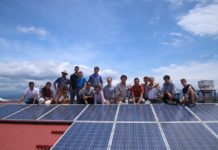Chiara Artini, student from Sapienza University, Rome 
Musanze is the second biggest city of Rwanda (about 90.000 people). Many hydropower plants are in construction in the surrounding region, as it is rich in water.
There, we visited Kigasa plant building site with Nicola Stenico, the project manager, a former student of FSA.
The power of the plant is 195kW, with a head of 80m from the intake (1764m a.s.l.) to the powerhouse (1684m a.s.l.), a flowrate of 0.4, and a global efficiency of 62%.
The water is taken through a koanda grid. This innovative technology diverts water flow and thanks to the koanda effect it allows a very accurate filtering of the water, moreover avoiding the construction of the sedimentation tank.
In conventional plants, the water is taken through a normal filter, then sent down in an open channel to a sedimentation tank in order to prevent solid particulate to damage mechanical parts. Clean water therefore reaches another tank, and flows toward the turbine through a penstock.
If the water is taken through a koanda grid instead, it’s possible to use an underground pipe to keep water clean and under pressure during the whole path (from the intake to the turbine), while the sedimentation tank is replaced by a fore bay tank, directly below the grid.
Most of all, this technology exploits in the best way the difference in height between the intake and the power house, as the water is always under pressure and stores its energy.
The use of an innovative technology as the koanda grid in a developing country surprised us. 
The project manager told us that in these countries, although a complete developing process hasn’t taken place, new technologies are often employed.
This gap in their growth is generally called “leapfrog”.
The turbine is a Pelton with vertical axis, four injectors, and power generator on the same axis, above the turbine. The plant will be linked to the national grid, in medium voltage.
But our visit wasn’t just tubes and turbines!
We walked through the building site from the intake to the powerhouse along the tube, still not buried (as the plant has not finished yet), in quite a wild nature. Children from close villages followed us. We walked, sang and played with them while visiting the building site. It was difficult to focus on the plant in such a joyful atmosphere, but they made extraordinary our experience.







